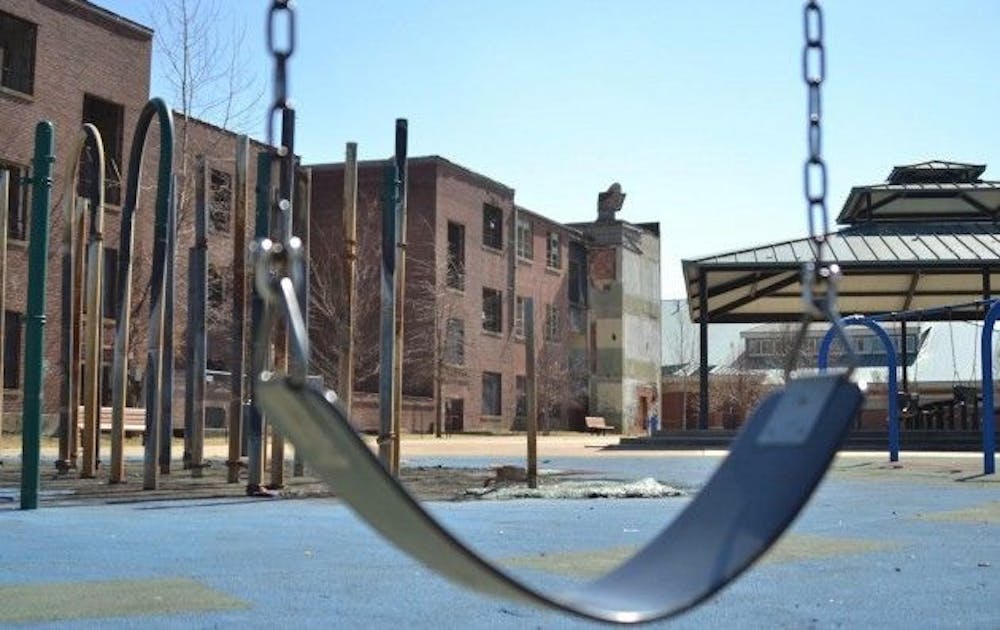Time, weather and rock-wielding teenagers shattered nearly every window in the old three-story Melrose school building. Fluorescent light fixtures, twisted and red from rust, dangle in the abandoned classrooms. A patchwork of plywood and iron bars conceals man-sized holes dug into the brick walls.
In some ways, the structure emulates the boarded up shotgun-style homes seen throughout the Orange Mound area.
What separates this building from others like it in Memphis is the 8-foot-tall silver painted sign that reads "National Register of Historic Places."
Built in 1938, the once state-of-the-art school contained two dozen classrooms, a library and health clinic. Melrose stood as a "pillar of education" for African-Americans in Orange Mound during an age divided by segregation, explained Mary Mitchell, chairwoman for the Melrose Center for Cultural Enrichment.
Starting in the ninth grade in 1952, Mitchell walked to the school almost every day, encouraged by her neighborhood.
"Education was prized in early Orange Mound," Mitchell said. "Children who could read were asked to help the illiterate members of the community."
Melrose also provided basic education classes for black adults who either never got the opportunity to go to school or were previously forbidden, Mitchell said.
"My uncle would get off work and take a first grade, wide-line writing tablet to Melrose," She said. "Most of his life he had to use an 'X' to sign anything. So when they taught him how to spell his own name, he was so excited that he wrote it on everything."
Famous doctors and athletes also attended school at the old Melrose building. Dr. Alvin Crawford, the first black student to receive a medical degree from the University of Tennessee, graduated from Melrose in 1957. Larry Finch, famous head coach for the University of Memphis basketball team, first played for the Melrose Wildcats in the early '70s.
Closed in 1979, the structure sat empty for nearly two decades before rumors of it being demolished arose. The memories and history of this place compelled Mitchell and Alcine Arnett, former chairwoman of M.C.C.E., to organize the Melrose alumni in an effort to preserve it.
"We were dedicated to saving the school even if it meant chaining ourselves to it," Mitchell said. "It had a marble foyer and mahogany staircases. It is just a beautiful place."
They campaigned to keep the school standing based on its significance to the black community and it being the last building in Memphis to be constructed by President Franklin D. Roosevelt's Public Works Administration.
Their efforts paid off in May 2001 when the N.R.H.P. inducted the structure and erected a sign declaring its significance. Later that year, David Royer, architectural surveyor for Memphis Heritage Inc., wrote that old Melrose would be transformed into a place celebrating the community's history. But with no money, it sat unused.
Mitchell said she wants it to be renovated into a museum, but, in May 2013, Memphis City Schools held pre-biddings and planned for its demolition. Yet the school board will not tear it down, Michael Saine, executive director for the Orange Mound Development Corporation, said.
"The school system is just trying to reduce their liability," Saine said. "The building is structurally sound so there is no fear that it will collapse."
Because of its historic site status, the building cannot be easily demolished and no new development can be built on the plot even if it were, Saine said. However, he admitted that some in the community would like to see it removed.
"Orange Mound is divided in half between those who want it gone and those who want to keep it," he said. "It is not because they care about its history, they just don't want to see their Melrose in its current condition."
Saine said she envisions the building being changed into a senior living center.
"You have a lot of seniors living in dilapidated houses," he said. "They live on a fixed income and can't afford to repair them. They worked all of their lives getting these homes, so telling them to move into a living center is a hard sell. But if it was close to the community center, they might be open to the idea."
However, even modest renovations would cost millions of dollars, Saine estimated. It is unlikely that the city will fund even part of the cost anytime soon. The old Melrose school continues to be trapped in slow deterioration, but Mitchell still has hope.
"I pray every day," she said. "I just know a philanthropist and the city will come through and save old Melrose."




